#Long-jawed Orbweavers
Explore tagged Tumblr posts
Text

Unknown Stretch Spider (genus Tetragnatha), April '24.
#ljsbugblog#bugblr#entomology#macro#unconfirmed id#arachnids#spiders#araneoidea#orbweavers#tetragnathidae#long-jawed orbweavers#tetragnatha#stretch spiders
30 notes
·
View notes
Text


Flat Spider
Unidentified, family Tetragnathidae
22/03/23 - NSW
#Tetragnathidae#unidentified#Long-jawed Orbweavers#Araneae#Spiders#spiders tw#Arachnida#Arachnids#Chelicerata#Chelicerates#insectblr#bugs#bugblr#bugs tw#bug#entomology#Arthropods#Arthropoda#invertebrates#invertblr
64 notes
·
View notes
Photo


Giraffe big-jawed spider, Dolichognatha sp.? Tetragnathidae
Photographed in Singapore by Nicky Bay // Website // Facebook
Shared with permission; do not remove credit or re-post!
#animals#curators on tumblr#bugs#arachnids#spider#long jawed orbweaver#tetragnathidae#giraffe big jawed spider#one nice bug
2K notes
·
View notes
Text

Red-and-blue Long-jawed Orb-weaver (Leucauge sarawakensis), family Tetragnathidae, Sarawak, Borneo
photograph by cclborneo
544 notes
·
View notes
Text


Long-Jawed Orbweaver - tetragnatha
2 notes
·
View notes
Text
#1997 - Tetragnatha sp. - Long-jawed Orbweaver

Photo by Patrick Wake.
Another species of Long-jawed spider from Cooleenup Island. Quite different in colour from the ones I've posted in the past. Fabulous view of the huge jaws that the males and females compare when judging each other as mates
8 notes
·
View notes
Text
saw this interesting pair here on a blade of grass! a marsh fly and a long-jawed orbweaver, sharing a resting spot during the rain
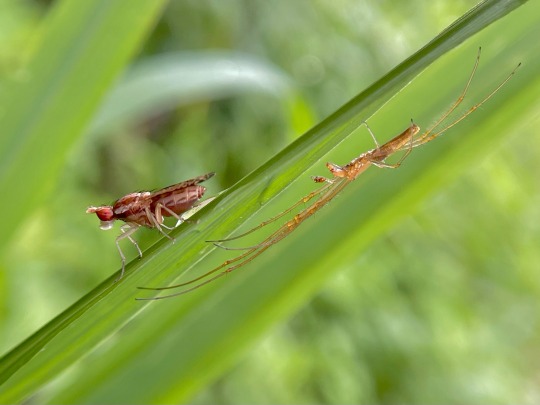


Trypetoptera canadensis and Tetragnatha sp.
533 notes
·
View notes
Text

Am guessing this is one of the long-jawed orbweavers (Tetragnatha), check out the long jaws and what appear to be some sort of specialized palps? Just another successful experiment by our friend Nature. Photo by Jade Louis. <b> ~~~~~~~~~~{{{{{{0}}}}}}~~~~~~~~~~</b>
All photographs are public domain, feel free to download and use as you wish.
16 notes
·
View notes
Text

gorgeous long jawed orbweaver outside my house
14 notes
·
View notes
Text
How to Identify Cross Orbweaver Spiders
Originally posted on my website at https://rebeccalexa.com/how-to-identify-cross-orbweaver-spiders/. Click here to learn more about the How to Identify article series.
Name: Cross orbweaver spider (Araneus diadematus), also known as cross spider, European garden spider, et. al.
Range and typical habitat(s): Native to much of Europe, sporadically found in temperate areas of Asia, introduced to North America, particularly the west coast and northeast United States.
Distinguishing physical characteristics (size, colors, overall shapes, detail shapes) and behaviors: Fall is just around the corner, and if you’re looking for more eco-friendly seasonal decorations, the cross orbweaver is the perfect fit! While these spiders have spent all summer chowing down on insects, by September they’ve gotten big enough to be quite visible on their large orb webs.
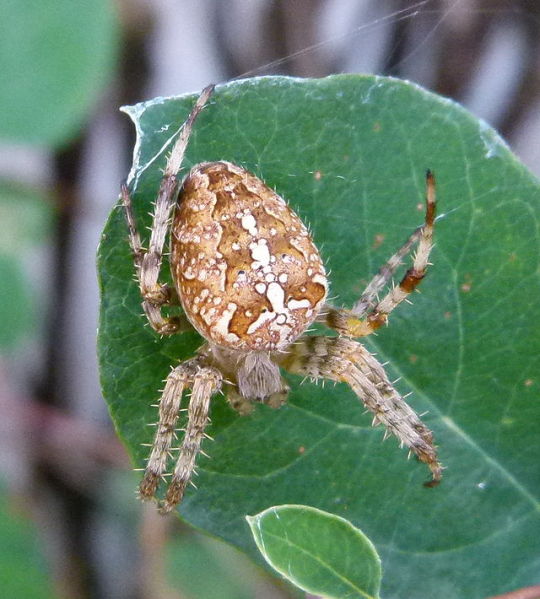
A mature female cross orbweaver spider.
Both sexes are a variable combination of orange, yellow, brown, and/or gray, and they all have white cross-shaped markings on the dorsal (upper) side of their rather large, oval-shaped abdomens. The legs are tan to orange with darker brown or gray stripes. Like many other web-weaving spiders, cross orbweavers tend to rest in the center of their web with their head facing down and their legs flexed rather than straight, though the fourth pair in the back may sometimes be extended somewhat. Their legs are covered in fine hairs with a fuzzy appearance. They are also known to perch on nearby leaves and twigs.
Like other members of the family Araneidae, the orb-weavers, these spiders have four pairs of eyes. Females are larger than males, reaching up to 1″ long in exceptional individuals, while males usually top out at 1/2″ or less. A close examination shows that males can also be distinguished by large pedipalps with swollen ends. These are little appendages nestled between the chelicerae (jaws) and the first pair of legs. Males use the pedipalps in mating displays, and to also pass sperm to the female. A courting male needs to be careful, as females will engage in cannibalism.
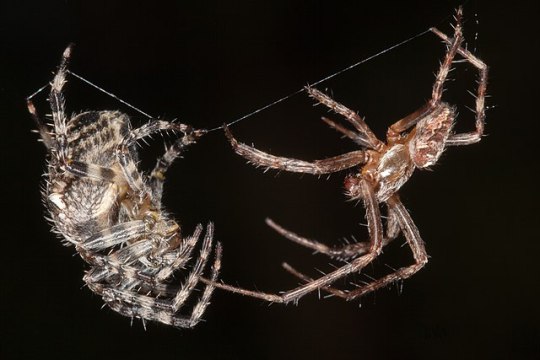
A male cross orbweaver (right) carefully approaches a female (left) with the intent to mate.
The eggs laid by females the previous fall hatch in spring, releasing several dozen (or more!) tiny yellow spiderlings into the world. While they make webs as soon as they find a good location, these young spiders often end up as prey for other animals themselves. Cross orbweavers generally live no more than a year, though females die shortly after laying their eggs, and males are often eaten by their mates.
The web is made of a series of overlapping threads of silk like the spokes in a wheel, with a spiraling orb starting at the center and working its way outward. A cross orbweaver’s web may be quite large, and the central orb may at times exceed two feet in diameter. They are not picky about where they set up shop, and are often found near homes and other buildings, where they are quite adept at catching flying insects that blunder into the web. If threatened, these spiders shake their web vigorously, and are not prone to bite unless handled roughly. They may dry bite in self-defense, choosing not to use venom. Their venom is not considered dangerous to humans.
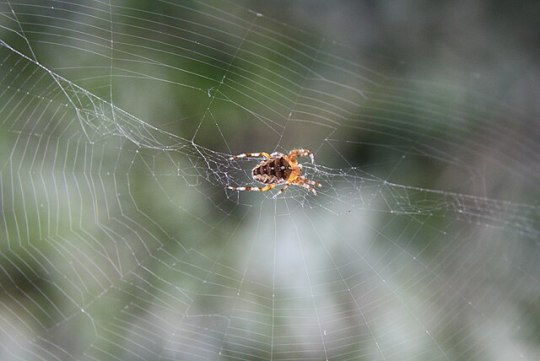
Other organisms it could be confused with and how to tell the difference: There are several other Araneus species that look quite similar to the cross orbweaver. Of these, the most similar is the four-spot orbweaver (Araneus quadratus) has less variegated orange, green, or brown abdomen with four small white spots on it rather than a cross, though they have similarly striped legs. It is found only in Europe.
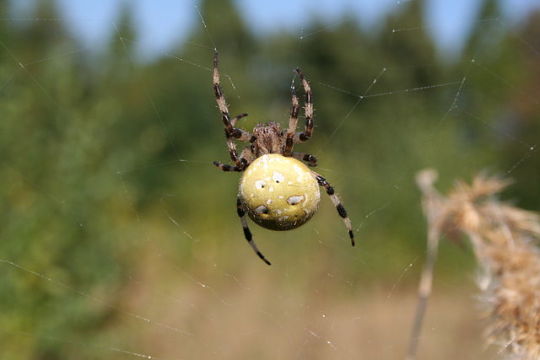
Araneus quadratus
The cat-faced spider (Araneus gemmoides), also known as the jewel orbweaver, is of similar size and color variation to the cross orbweaver. However, its abdomen has two pronounced points on top that look rather like a cat’s ears. Araneus gemma (not pictured) is also sometimes called the cat-faced spider or the gem-shaped spider, and it has a similarly shaped abdomen but tends to be paler in color. Both of these species are primarily found in the western half of temperate North America.
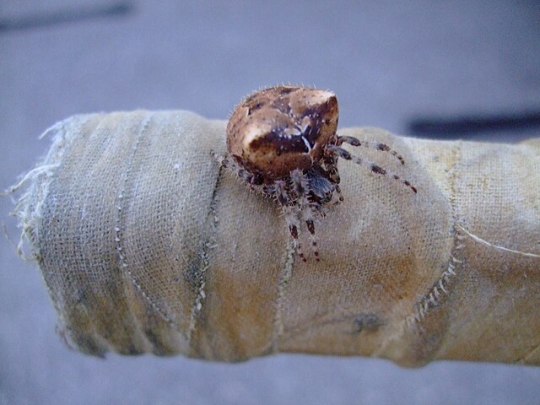
Araneus gemmoides. By Trucmuche04, CCA-SA-3.0
Anything else worth mentioning? Because the cross orbweaver is not native to North America, it competes with native spiders for food. This is especially concerning as insect populations have plummeted in recent decades due to pesticide use and habitat loss. It is often found in urban areas and other places with lots of human habitation, and is considered an invasive species in the Bay Area. They are considered harmless to humans.
Further Reading:
Cross Orbweaver Spider
Cross Orbweaver
Cross Orbweaver (Araneus diadematus)
Spiderspotter: Cross Orbweaver
Did you enjoy this post? Consider taking one of my online foraging and natural history classes or hiring me for a guided nature tour, checking out my other articles, or picking up a paperback or ebook I’ve written! You can even buy me a coffee here!
#spider#spiders#cw spiders#spider tw#cross orbweaver#orb weaver#arachnids#arthropods#invertebrates#bugs#wildlife#animals#wild animals#nature#nature identification#invasive species#biodiversity#science#scicom
56 notes
·
View notes
Text
Bugs I found in the past few days :3








In order
Tubeworm moth
A lacewing (I think? Correct me if I’m wrong)
Long jawed orbweaver spider
A vacant wasp nest
A pitiful little waxed sphinx moth that I tried to save
Grasshopper
A baby borrow orbweaver (last two pics are the same spider)
#my pics#photography#oddcore#random#looking for friends#looking for moots#looking for mutuals#random photos#random pics#randomcore#i love bugs#bugblr#tw bugs#bugcore#bug#bugs#i love spiders#tw spiders#grasshopper#wasp nest#moths#i love moths#lacewing#orb weaver#alt boy#alternative#random shit#random stuff#random bugs#bug blogging
15 notes
·
View notes
Text

my first male Silver Orb! observed cruising around looking for ladies.


Silver Orb Spider, male (Leucauge dromedaria), March '24.
#ljsbugblog#bugblr#entomology#macro#arachnids#spiders#araneoidea#orbweavers#tetragnathidae#long-jawed orbweavers#leucauge#leucauge dromedaria#silver orb spider
31 notes
·
View notes
Text


saw this spider trying to set up shop on my door yesterday and finally identified her as a species of long jawed orbweaver. very beautiful very powerful.
1 note
·
View note
Text



Orchard Orbweaver (Leucauge venusta), female, family Tetragnathidae, Clark County, Ohio, USA
photograph by Terri Norris
#orbweaver#long jawed orbweaver#leucauge#tetragnathidae#spider#arachnid#entomology#animals#nature#north america
642 notes
·
View notes
Text
Went kayaking a bit later than usual today, so gave up on doing the two-hour creek loop. We're in a drought and the water level of the river looked to be at least two feet lower than usual, judging by the water lines on the trees. Lots more stumps and knees and LAND. Less aquatic plants than last time. My hat is floppy again, having melted in the hot car. Might have to reinforce it with fishing line instead. Looking forward to having a sore back from something other than my terrible posture
Ate a grilled zucchini sandwich and drank sweet tea on a formerly underwater log on a little beach. Went a little ways into the creek. Someone moved the floating dock! Or the floating dock moved on its own? Would be a fun place to camp. Saw an alligator on my way back. Explored a cool little creek near the boat ramp. Too crowded, too many jet skis and motorboats. Don't go back on the weekend. Photographed what I now realize were apple snail eggs. Invasive here but very cool-looking! Long-jawed orbweavers (family Tetragnathidae). A dark fishing spider (D. tenebrosus). Gnats and dragonflies
Boats blasting country music I didn't recognize and a country cover of Springsteen's "I'm on Fire." Another blasting "Party in the USA" and "Die Young." Wondered what nostalgic country music for people who grow up listening to it is. Will have to ask T. Lay in my kayak and stared up at the trees as it got dark. Looked for spiders by headlamp
#text#kayaking#peachtree#oh wait i think T said their parents just...didn't listen to music?#fucking weird
1 note
·
View note
Text
#2575 - Leucauge dromedaria - Silver Orb Spider

AKA the humped silver orb spider, originally described as Meta granulata by Swedish arachnologist Tamerlan Thorell in 1842.
A medium to large sized Longjawed Orbweaver, with a body length up to 15 mm long in he females, and the males usually under 6 mm. Found in Australia, some south Pacific Islands and New Zealand.
Pancake Rocks, Aotearoa New Zealand
#leucauge#spider#tw: spider#tetragnathidae#long-jawed orbweaver#orbweaver#orb-weaving spider#new zealand spider
1 note
·
View note